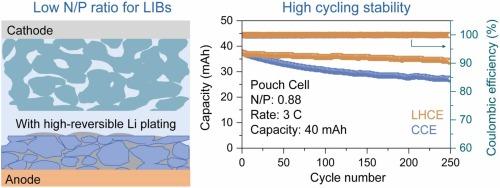正负比对快充锂离子电池界面兼容性的影响
IF 6.3
2区 材料科学
Q2 CHEMISTRY, PHYSICAL
引用次数: 0
摘要
利用局部高浓度电解液(LHCEs)在石墨(Gr)阳极上可逆镀锂是提高锂离子电池(LIBs)快速充电能力的一种实用方法。然而,在实际的全电池中,阳极表面镀锂的加载边界仍然不清楚,这需要界面兼容性和循环耐久性。本文研究了负极与正极(N/P)比值在0.55 ~ 1.13范围内对LiFePO4||Gr电池使用常规浓缩电解质(CCE)和LHCE快速充电性能的影响。结果表明,与CCE电池相比,lhce衍生的固体电解质界面具有更高的物质分布均匀性和阳极界面稳定的锂离子通量,有利于均匀和可复制的镀锂。LHCE电池的N/P比为0.88,在1~3℃条件下可保持300次循环的长期稳定性,与N/P比更高的传统类型电池(1.13)相当。自制的40 mah N/P为0.88的LiFePO4||Gr袋状电池在LHCE中进行了3次c循环,250次循环后容量保持率达到92.8%。本研究为提高锂离子电池的快速充电效率和降低电池材料成本提供了界面相容性方面的见解。本文章由计算机程序翻译,如有差异,请以英文原文为准。

The effect of negative-to-positive ratios on the interfacial compatibility for fast-charging lithium-ion batteries
Reversibly cycling Li plating on the graphite (Gr) anode using localized high-concentration electrolytes (LHCEs) is a practical approach to enhance the fast-charging capability of lithium-ion batteries (LIBs). However, the loading boundary of Li plating on the anode surface, necessitating interfacial compatibility and cycling durability, remains unclear in practical full cells. Herein, we investigate the impact of negative-to-positive (N/P) ratios ranging from 0.55 to 1.13 on the fast-charging performance of LiFePO4||Gr cells using the conventional concentration electrolyte (CCE) and LHCE. The results demonstrate that compared with CCE cells, the LHCE-derived solid electrolyte interphase featuring higher uniformity of species distribution and stable Li-ion flux at the anode interface can facilitate the homogenous and replicable Li plating. With a 0.88 N/P ratio, LHCE cells can maintain long-term cycling stability over 300 cycles at 1–3 C, which is comparable to the conventional type of cells with a higher N/P ratio (1.13). The self-made 40-mAh LiFePO4||Gr pouch cells with a 0.88 N/P are 3C-cycled in LHCE, exhibiting an excellent capacity retention of 92.8 % over 250 cycles. This study provides insight into the interfacial compatibility of Li plating to enhance the fast-charging efficiency of LIBs while reducing the cost of cell materials.
求助全文
通过发布文献求助,成功后即可免费获取论文全文。
去求助
来源期刊

Journal of Alloys and Compounds
工程技术-材料科学:综合
CiteScore
11.10
自引率
14.50%
发文量
5146
审稿时长
67 days
期刊介绍:
The Journal of Alloys and Compounds is intended to serve as an international medium for the publication of work on solid materials comprising compounds as well as alloys. Its great strength lies in the diversity of discipline which it encompasses, drawing together results from materials science, solid-state chemistry and physics.
 求助内容:
求助内容: 应助结果提醒方式:
应助结果提醒方式:


